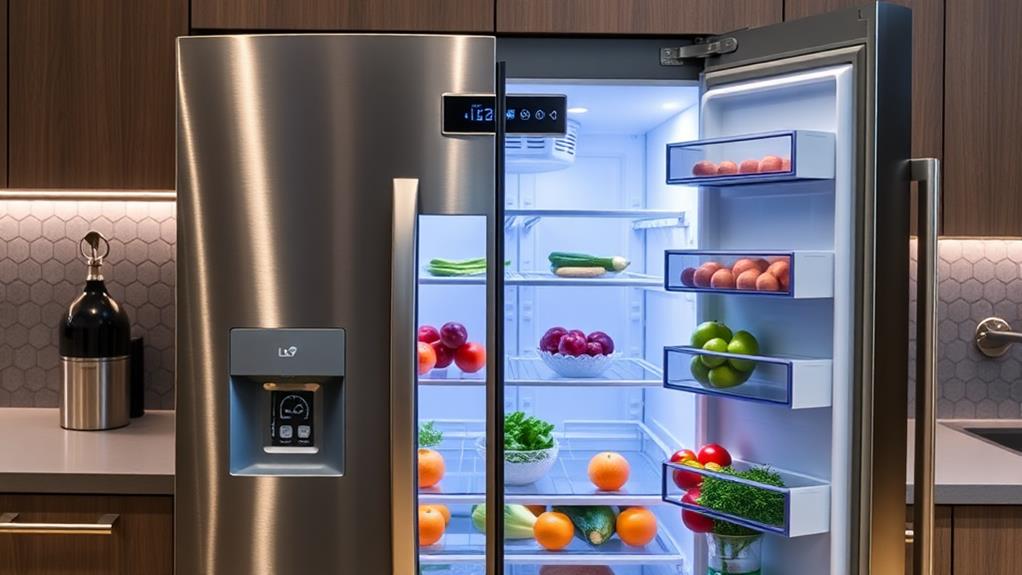When shopping for an energy-efficient refrigerator, look for models with Energy Star certification, which use about 15% less energy than non-certified ones. Advanced insulation technology and efficient compressors help maintain consistent temperatures while reducing power consumption. Smart temperature controls and LED lighting further enhance efficiency. Consider fridges with adjustable humidity drawers and multi-zone cooling systems to keep food fresher longer. Inverter technology allows for variable-speed operation, saving energy and reducing noise. Don't forget about automatic defrost mechanisms, which prevent frost buildup and improve overall efficiency. These features not only save you money but also minimize your environmental impact.
Energy Star Certification
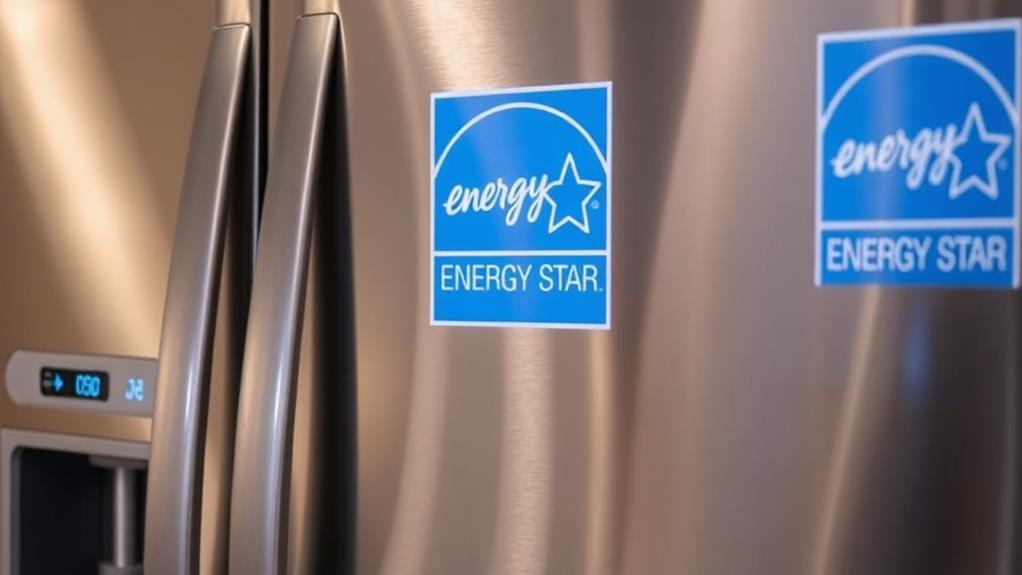
Nearly all energy-efficient refrigerators on the market today boast Energy Star certification. This label, backed by the U.S. Environmental Protection Agency and Department of Energy, indicates that the appliance meets strict energy efficiency guidelines. When you're shopping for a new refrigerator, look for the blue Energy Star logo to ensure you're getting a model that'll save you money on energy bills and reduce your carbon footprint.
Energy Star certified refrigerators use about 15% less energy than non-certified models. Over time, this can translate to significant savings on your electricity costs. These fridges achieve their efficiency through various features, such as improved insulation, more efficient compressors, and precise temperature controls.
To qualify for Energy Star certification, refrigerators must undergo rigorous testing and meet specific criteria. These standards are regularly updated to push manufacturers towards even greater energy efficiency. When you choose an Energy Star certified fridge, you're not just saving money; you're also supporting ongoing innovation in energy-efficient appliance technology. Remember, the energy savings can vary depending on your specific usage and the model you choose, so it's worth comparing the yellow EnergyGuide labels on different refrigerators to get a more precise estimate of annual energy consumption and operating costs.
Advanced Insulation Technology
Modern energy-efficient refrigerators rely heavily on advanced insulation technology to maintain consistent temperatures while minimizing energy loss. When you're shopping for a new fridge, look for models that feature high-performance insulation materials like polyurethane foam or vacuum-insulated panels.
These cutting-edge insulators create a robust barrier against heat transfer, keeping your food cold without overworking the compressor. You'll find that fridges with superior insulation maintain more stable internal temperatures, reducing energy consumption and preserving food quality for longer periods.
Some manufacturers have developed multi-layered insulation systems that combine different materials for optimal performance. You might also encounter models with "smart" insulation that adapts to ambient conditions, further enhancing efficiency.
Don't overlook the importance of door seals and gaskets. Energy-efficient fridges often feature improved magnetic seals that create an airtight closure, preventing cold air from escaping. Some even incorporate anti-sweat heaters in the door frame to prevent condensation without significantly impacting energy use.
Efficient Compressors
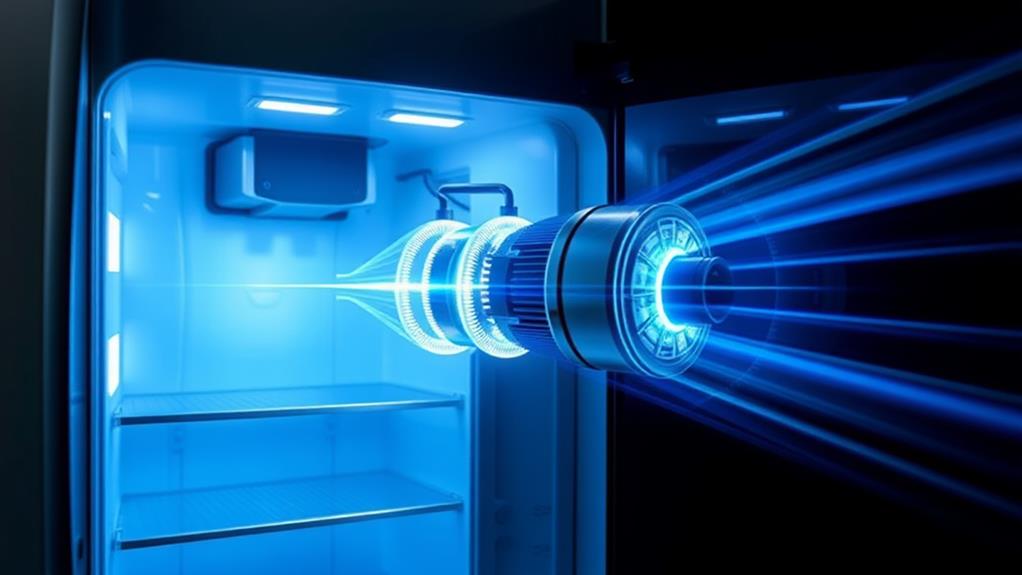
The heart of any refrigerator's cooling system is its compressor. When shopping for an energy-efficient refrigerator, you'll want to pay close attention to this crucial component.
Modern efficient compressors use variable speed technology, allowing them to adjust their operation based on cooling needs. This means they don't constantly cycle on and off, which saves energy and reduces wear and tear.
Look for models with inverter compressors, which can operate at different speeds and power levels. These compressors run more consistently at lower speeds, consuming less energy overall. They're also quieter and often have longer lifespans than traditional compressors.
Some manufacturers use linear compressors, which have fewer moving parts and operate more efficiently. They produce less friction and heat, translating to lower energy consumption and better cooling performance.
When comparing refrigerators, check the Energy Star rating and annual energy consumption figures. These will give you a good indication of the compressor's efficiency. Remember, a more efficient compressor not only saves you money on electricity bills but also helps reduce your carbon footprint. Don't hesitate to ask salespeople about the specific compressor technology used in the models you're considering.
Smart Temperature Controls
Smart technology has revolutionized temperature control in energy-efficient refrigerators. These advanced systems use sensors and algorithms to maintain optimal temperatures throughout the fridge and freezer compartments. You'll find that smart controls adjust cooling based on factors like door openings, ambient temperature, and food load.
Many models now offer smartphone connectivity, allowing you to monitor and adjust temperatures remotely. This feature comes in handy when you're away from home or want to pre-cool your fridge before returning from grocery shopping. Some fridges even learn your usage patterns and automatically adjust settings for maximum efficiency.
Look for refrigerators with multi-zone temperature controls. These allow you to set different temperatures for various compartments, ensuring ideal conditions for different food types. For example, you can keep your produce at a slightly warmer temperature than your dairy products.
Don't overlook the importance of clear digital displays. They'll help you easily monitor and adjust temperatures as needed. Some advanced models also provide alerts if the door is left open or if there's a power outage, helping you prevent food spoilage and energy waste.
LED Lighting
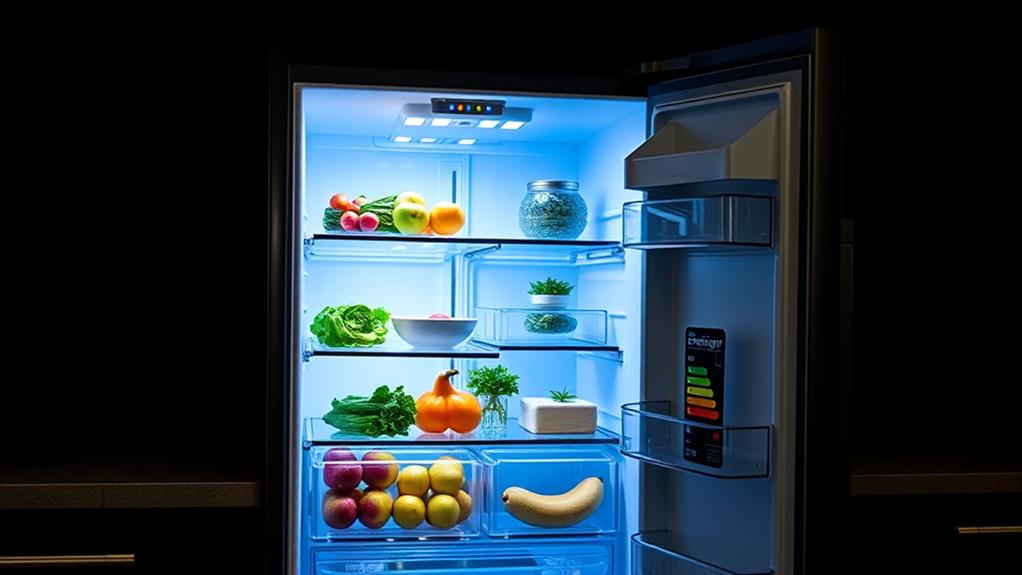
Alongside smart temperature controls, LED lighting plays a key role in boosting refrigerator energy efficiency. These modern lights consume significantly less energy than traditional incandescent bulbs, helping to reduce your appliance's overall power consumption. LED lights also generate less heat, which means your fridge doesn't have to work as hard to maintain its cool temperature.
You'll find LED lighting strategically placed throughout energy-efficient refrigerators. Look for models with LED bulbs illuminating the main compartment, crisper drawers, and even the freezer section. This comprehensive lighting ensures you can easily see all your stored items without having to keep the door open for extended periods.
Many advanced refrigerators now feature motion-activated LED lights. These sensors detect when you open the door and automatically turn on the lights, then switch them off when you close it. This smart feature prevents unnecessary energy use if you accidentally leave the door ajar.
Some high-end models even offer customizable LED lighting options. You can adjust the brightness or color temperature to suit your preferences, creating the perfect ambiance in your kitchen while still maintaining energy efficiency.
Door-in-Door Design
In addition to LED lighting, door-in-door design has become a popular feature in energy-efficient refrigerators. This innovative design allows you to access frequently used items without opening the main refrigerator door, reducing cold air loss and improving energy efficiency.
When you open the outer door panel, you'll find a separate compartment for storing beverages, condiments, and snacks. This compartment is typically mounted on the refrigerator's main door, creating a convenient storage space that's easily accessible. By using this feature, you'll minimize the amount of time the main door stays open, helping maintain a consistent internal temperature.
The door-in-door design also offers organizational benefits. You can keep your most-used items within easy reach, reducing the time spent searching for items and potentially leaving the door open longer. Some models even include adjustable shelves or bins in this compartment, allowing you to customize the space to your needs.
While the door-in-door feature can contribute to energy savings, it's important to consider your usage habits. If you frequently access items throughout the day, this design could significantly reduce your refrigerator's energy consumption and potentially lower your electricity bills.
Adjustable Humidity Drawers
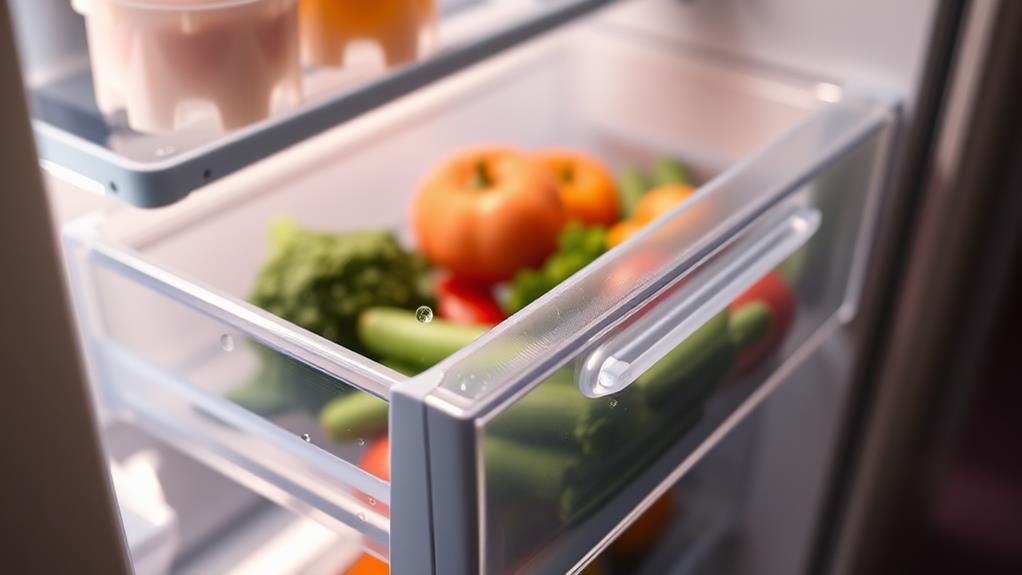
Another key feature of energy-efficient refrigerators is adjustable humidity drawers. These specialized compartments allow you to control the moisture levels for different types of produce, helping to extend their freshness and reduce food waste. You'll typically find two types of drawers: high-humidity for leafy greens and low-humidity for fruits and vegetables that emit ethylene gas.
By adjusting the humidity levels, you're creating optimal storage conditions for your produce. This means you'll need to shop less frequently, saving energy on transportation and reducing the number of times you open your refrigerator door. The drawers are often designed with tight seals to maintain the set humidity levels, which also helps prevent cold air from escaping.
When shopping for a refrigerator with adjustable humidity drawers, look for models with clear, easy-to-use controls. Some advanced models even offer preset options for specific types of produce. You'll also want to consider the size and number of drawers to ensure they meet your household's needs. By properly using these drawers, you're not only conserving energy but also saving money on groceries and reducing your environmental impact.
Multi-Zone Cooling Systems
Multi-zone cooling systems take energy efficiency up a notch in modern refrigerators. These systems divide your fridge into separate cooling zones, each with its own temperature control. You'll find this feature particularly useful if you're looking to optimize food storage and reduce energy consumption.
With multi-zone cooling, you can set different temperatures for various compartments. For example, you might keep your fruits and vegetables at a slightly warmer temperature than your dairy products. This customization allows you to store each food item at its ideal temperature, prolonging freshness and reducing waste.
The system works by using multiple evaporators or air flows, ensuring that each zone maintains its set temperature independently. This means when you open one compartment, the others aren't affected, minimizing temperature fluctuations and energy loss.
You'll also appreciate the improved air circulation in multi-zone systems. They prevent odors from mixing between compartments, keeping your foods fresher and tastier. Plus, by cooling only the zones you're using, you'll save energy and potentially lower your electricity bills.
When shopping for an energy-efficient refrigerator, look for models featuring multi-zone cooling systems to maximize both food preservation and energy savings.
Inverter Technology

Efficiency takes a quantum leap with inverter technology in modern refrigerators. This innovative feature allows your fridge to operate at variable speeds, unlike traditional compressors that work at a fixed rate. When you're shopping for a new refrigerator, you'll want to pay close attention to models equipped with inverter technology.
Inverter-equipped refrigerators adjust their cooling power based on the internal temperature and usage patterns. They'll run at a higher speed when cooling is needed, then slow down to maintain the temperature. This results in significant energy savings, as the compressor isn't constantly cycling on and off at full power. You'll notice reduced electricity bills and a longer lifespan for your appliance.
Another benefit you'll appreciate is the reduced noise level. Since inverter compressors operate more smoothly and consistently, they produce less vibration and sound. This technology also helps maintain more stable temperatures inside your fridge, which can help keep your food fresher for longer. When considering energy-efficient refrigerators, look for models that highlight their inverter technology – it's a feature that'll pay off in the long run.
Automatic Defrost Mechanisms
Typically, modern refrigerators come equipped with automatic defrost mechanisms, saving you time and effort. These systems prevent frost buildup in the freezer compartment, which can reduce energy efficiency and storage space. Automatic defrost works by periodically heating the evaporator coils to melt any accumulated frost, then draining the water away.
You'll find two main types of automatic defrost systems: cyclic defrost and frost-free. Cyclic defrost operates on a timer, activating the defrost cycle at set intervals. Frost-free systems use sensors to detect frost buildup and initiate the defrost cycle only when necessary, potentially saving more energy.
While automatic defrost is convenient, it does consume some extra energy. However, this is often offset by improved overall efficiency, as frost buildup can make your refrigerator work harder. When shopping for an energy-efficient model, look for refrigerators with adaptive defrost systems that learn from your usage patterns and optimize defrost cycles accordingly. These advanced systems can further reduce energy consumption while maintaining optimal performance. Remember, proper maintenance, like keeping door seals clean and closing the door quickly, can help minimize frost buildup and reduce the frequency of defrost cycles.
Conclusion
You've now got the knowledge to choose an energy-efficient refrigerator that'll save you money and reduce your carbon footprint. Remember, these features work together to maximize efficiency. Did you know that ENERGY STAR certified refrigerators use about 15% less energy than non-certified models? That's a significant saving over the appliance's lifetime. When shopping, prioritize these features to make an informed decision that'll benefit both your wallet and the environment.
